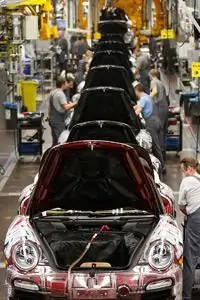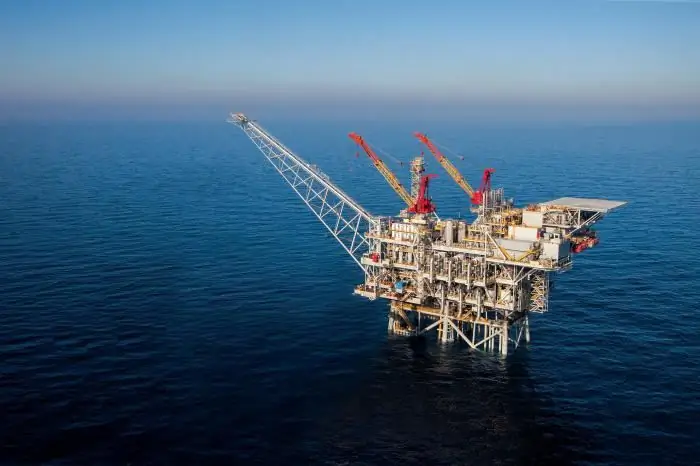2025 Author: Howard Calhoun | [email protected]. Last modified: 2025-06-01 07:12:56
Vinyl chloride is one of the simplest derivatives of acetylene obtained by adding hydrogen chloride. The main type of chemical reactions in which this substance is involved is the polymerization process. The final product - PVC - is widely used in all spheres of human activity. The process of manufacturing the compound and its derivatives is accompanied by the release of volatile substances, which have a strong toxic effect on the human body.
General Description
Vinyl chloride (vinyl chloride) is one of the most widely used chemical compounds as it is the raw material for PVC production. This substance was first obtained by Liebig in 1830 in Germany from dichloroethane and alcoholic potassium carbonate. After 42 years, another German chemist, Eugen Baumann, drew attention to the fact that when stored in the light, flakes begin to precipitate from vinyl chloride. This scientist is considered the discoverer of polyvinyl chloride.
At first, this compound did not arouse any interest among merchants and manufacturers of chemical products. Its production on an industrial scalestarted in the 30s. XX century.
The empirical formula for vinyl chloride is: C2H3Cl. The structural formula is shown in the figure below.

Under normal conditions, vinyl chloride is a colorless gas, but since its boiling point is -13 ° C, it is usually handled in a liquid state.
Chemical properties of vinyl chloride
The main reactions inherent in this substance are:
- Polymerization.
- Substitution on the carbon-chlorine bond. This process produces alcoholates and vinyl esters. The chlorine atom is replaced in the presence of catalysts: halides, palladium and s alts of other metals. If alcohol is used as solvents, then esters are synthesized.
- Oxidation with oxygen in the gas phase. The products of this reaction are formyl chloride, carbon monoxide, hydrochloric acid and formic acid. Complete oxidation is observed with the participation of a cob alt chromite catalyst or in an aqueous solution using potassium permanganate. Reaction with ozone in the liquid and gaseous state of vinyl chloride leads to the formation of formyl chloride and formic acid. Spontaneous combustion produces carbon monoxide, hydrochloric acid and toxic phosgene (in small quantities).
- Addition reactions. To obtain trichloroethane, which is used as a solvent, chlorine addition reaction is carried out: by the ionic mechanism (in the liquid phase, in the absence of light, using a catalyst based on transition metals) or by the radicalreactions (at elevated temperature). Useful vinyl chloride products are also synthesized by acid catalysis and hydrogenation.
- Photodissociation. Under the action of light with a wavelength of 193 nm, the HCl and Cl groups are split off from the vinyl chloride molecule.
- Pyrolysis. Vinyl chloride is more resistant to thermal decomposition than other haloalkanes of this type. Pyrolysis starts at 550°C. At 680°C, the yield of acetylene, hydrochloric acid, chloroprene, and vinylacetylene is about 35%. In the presence of water, vinyl chloride will corrode iron, steel, and aluminum by releasing HCl.
Polymerization reaction
Vinyl chloride monomer can exist for a long time under normal conditions. The appearance of radicals as a result of photo- or thermochemical reactions leads to the activation of polymerization.
This process takes place in 3 stages and is shown in the figure below.

Physical characteristics
The main physical properties of the compound under normal conditions are as follows:
- molecular weight - 62, 499;
- melting point - 119 K;
- boiling point - 259 K;
- heat capacity in the liquid state - 84 J/(mol∙K);
- vapor pressure at 0 °C - 175 kPa;
- Viscosity at -20 °C - 0.272 mPa∙s;
- lower explosive limit - 8.6% (by volume);
- auto-ignition temperature - 745 K.
The substance has good solubility in hydrocarbons,oils, alcohols, organic liquids; practically immiscible with water.
Receive
There are several industrial ways to get vinyl chloride:
- as a result of the reaction of hydrochloric acid with acetylene;
- from ethylene and chlorine (direct chlorination of ethylene, obtaining ethylene dichloride, its pyrolysis to vinyl chloride);
- ethylene oxychlorination;
- combined method (direct chlorination, pyrolysis of ethylene dichloride, oxychlorination) - an equilibrium process of ethylene and chlorine without the formation or consumption of hydrochloric acid.
Currently, the latter option is the most common and cost-effective. The amount of vinyl chloride obtained by this technology is more than 95% of the total world production. The chemistry of the reactions is shown in the figure below.

The entire volume of acid, which is obtained during the pyrolysis of ethylene dichloride, is used as a raw material in the next stage of production (oxychlorination). The resulting product is purified by distillation, by-products are used in the production of solvents or recycled.

Production in Russia

In Russia, the production of vinyl chloride from acetylene is carried out at the following enterprises:
- AK Azot, (Novomoskovsk, Tula region).
- JSC Plastcard (Volgograd).
- JSC Khimprom(Volgograd).
- Usolekhimprom JSC, (Usolye-Sibirskoye, Irkutsk region).
On the basis of ethylene, the synthesis of a substance is carried out in organizations such as:
- JSC "Sayanskkhimplast" (Sayansk).
- JSC Sibur-Neftekhim (Caprolactam, Dzerzhinsk).
- ZAO Kaustik (Sterlitamak).
Synthesis from acetylene is considered obsolete technology. Using ethylene as feedstock has the following advantages:
- cheaper and more affordable raw materials;
- high yield of finished product;
- low power and water consumption;
- possibility of building high capacity production lines.
This method has been used by the world's leading manufacturers for over 40 years. The main promising directions for the development of industrial production of vinyl chloride in Russia are the introduction of new capacities, the transition to ethane feedstock, the spread of oxygen-assisted oxychlorination technology and the development of related industries for the sale of caustic soda, which is formed as a by-product.
Application

The vast majority of vinyl chloride produced is used to make polyvinyl chloride (PVC). According to statistics, more than 50% of the production of this polymer is in Asia.
Polyvinyl chloride is the most versatile material of all polymers. It can be used to produce both rigid building structures (pipes, external wall cladding, profiles) andelastic products (wires, cables, roofing materials). Unlike other polymeric materials, polyvinyl chloride under the influence of ultraviolet rays, oxidation and liquid hydrocarbons not only decomposes, but also partially cross-links polymer chains. This property is associated with the presence of chlorine atoms in the structure of the compound. The high competitiveness of PVC is also explained by its low price.
PVC is used to make the following products (in descending order of production volume):
- pipes and their fittings;
- siding;
- windows, doors;
- profiles (including fences and decking);
- floor coverings;
- roofing materials;
- consumer products;
- packaging;
- cables and wires (sheath, insulation);
- medical supplies;
- coatings, adhesives.
Other uses
A small proportion of vinyl chloride (about 1%) is used to produce copolymers, of which combinations with vinyl acetate, vinylidene chloride, acrylic series monomers and alpha-olefins are of practical importance. The first type of copolymers is the most widespread. These materials have the following trade names:
- vestolite;
- hostalitis;
- winnol;
- lukovil;
- corvik;
- jeon;
- sikron and others.
They are used to make products such as:
- linoleum and other floor coverings;
- window frames;
- facing tiles;
- faux leather;
- film;
- varnishes;
- nonwovens.
Toxicity

Vinyl chloride refers to highly dangerous compounds that lead to serious deterioration in the human body. The substance is volatile and the main route of entry is inhalation. The source is the production of vinyl chloride, PVC and products from it.
Vinyl chloride causes disturbances in the following organs and systems:
- CNS depression (dizziness, disorientation, toxic coma);
- damage to connective tissue and blood vessels;
- deterioration of reproductive function;
- carcinogenic effect (angiosarcoma of the liver is most often detected, tumors and other localizations develop);
- digestive system - hepatitis, cholecystitis, cholangitis, gastritis, peptic ulcer;
- circulatory and hematopoietic system - hypertension, coronary heart disease, eosinophilia, thrombocytopenia;
- disturbance of cholesterol and general metabolism;
- mutagenic effect, formation of chromosomal aberrations;
- inhibition of antimicrobial protection, reduced immune forces.
With prolonged exposure (from six months to 3 years) of toxic doses of this substance, "vinyl chloride disease" occurs. Its development goes through 3 stages, which are characterized by the following features:
- Weakness, migraine, nausea, anemia, soreness of the nail phalanges of the limbs, as well as their destructionbones. When the harmful influence stops, the changes are reversible.
- Inflammation of the peripheral nerves, resulting in loss of sensation; arrhythmia, pain in the heart area, violation of thermoregulation.
- Memory impairment, hallucinations, involuntary eye fluctuations, double image, sleep disturbance, decreased performance, pain in the stomach, nausea, vomiting, increase in bone pathologies.
Recommended:
Modern production. The structure of modern production. Problems of modern production

Developed industry and a high level of the country's economy are key factors influencing the we alth and well-being of its population. Such a state has great economic opportunities and potential. A significant component of the economy of many countries is the production
Gas production. Gas production methods. Gas production in Russia

Natural gas is formed by mixing various gases in the earth's crust. In most cases, the depth of occurrence ranges from several hundred meters to a couple of kilometers. It is worth noting that gas can form at high temperatures and pressures. In this case, there is no access of oxygen to the place. To date, gas production has been implemented in several ways, each of which we will consider in this article. But let's talk about everything in order
Formula of net assets on the balance sheet. How to calculate net assets on a balance sheet: formula. Calculation of net assets of LLC: formula

Net assets are one of the key indicators of the financial and economic efficiency of a commercial firm. How is this calculation carried out?
Polyvinyl chloride - what is it? Polyvinyl chloride production technology and applications

If you decide to use PVC in construction or repair, what it is, it is important to find out before starting work. This material belongs to synthetic thermoplastic textures
List of new productions in Russia. Review of new productions in Russia. New production of polypropylene pipes in Russia

Today, when the Russian Federation was covered by a wave of sanctions, much attention is paid to import substitution. As a result, new production facilities are being opened in Russia in various directions and in different cities. What industries are the most demanded in our country today? We offer an overview of the latest discoveries

